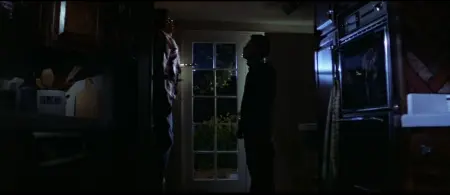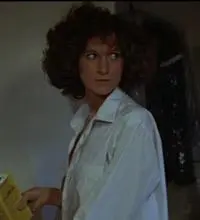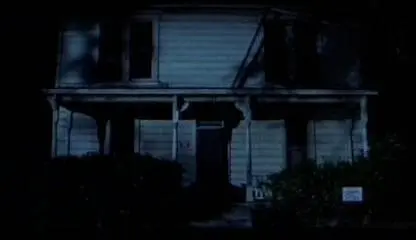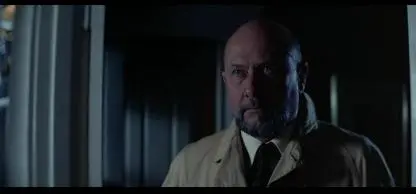Welcome once again to What Works & What Doesn't, whereby we take a classic or notable film and explore its effective and weak aspects in kind, determining what exactly works about the film and what doesn't (as the title of this series indicates). And as we are now firmly planted in the month of October, what better film to analyze than John Carpenter's breakout hit Halloween, featuring the now iconic characters Laurie Strode (Jamie Lee Curtis), Michael Myers AKA The Shape (Nick Castle) and Dr. Sam Loomis (Donald Pleasance).
The film is by and large now considered a classic, but there were quite a few critics at the time of its release that absolutely hated the film. Pauline Kaal is one such critic, who wrote in her review for The New York Times,
Halloween has a pitful, amateurish script (by Carpenter and his producer, Debra Hill). An escaped lunatic wielding a kitchen knife stalks people in a small Midwestern town (Haddonfield, Illinois), and that's about it. There's no indication of why he selects any particular target; he's the bogeyman—pure evil—and he wants to kill...
As a doctor from the lunatic asylum that the killer has escaped from, Donald Pleasence is solid and forceful; enunciating in the impeccable tradition of Lionel Atwill, he delivers idiotic exposition about e-vil. Sometimes you think he's going to have to cross his eyes to keep a straight face.
Although there were other reviews as scathing as Kaal's, there were also positive comments for the film. Roger Ebert praised the film's lack of violence and gore in favor of taut suspense, while Tom Allen of The Village Voice saw Halloween as the next logical step in the progression of "cult films." He writes,
...Halloween is a movie of almost unrelieved chills and of violence, conjuring up that unique mix of subliminal threat and contrapuntal physicality employed by Hitchcock....Carpenter's free, eclectic use of the subjective shot is enough to drive purists crazy: he uses it, though, as the basic resource of an unabashedly devious visual labyrinth in which every blank space, curve, and corner poses a threat. Halloween, after all, is a schlock film—the old one about the masked psycho ignited by any sight of pubescent sexuality. It would seem that Carpenter's duplicitous hype is the most honest way to make a good schlock film.
As far as I am concerned, Allen is wholly correct in his assessment—minus, that is, the idea that Michael Myers / The Shape is enraged by sex. This will not be the main crux of this column (I'm getting to that), but it is important to understand, straight away, that the sex factor is basically a red herring in this film—as far as the killer is concerned, there is no virgin-whore dichotomy here; there are only Halloween tricks and death.
Why is this so important? Well, for one thing, the "sex equals death" rule put to good meta use in Scream, in fact, comes from Halloween (erroneously, of course), leading to Friday the 13th, where this puritanical equation was applied to the extreme, which then led to countless other imitators as well as numerous Friday the 13th sequels. Thus, the slasher genre was born, with its whore-killing trope fully-intact. Put another way, Halloween is often cited as the first slasher film, never mind the fact it features hardly any blood and scant actual nudity, so much so that if American censors weren't so squeamish about female nipples, channels like AMC and TNT could show the film completely unedited (not to mention that slasher films owe far more to the gore films of Herschel Gordon Lewis and The Town That Dreaded Sundown than it does to Halloween).
But the other reason why separating the "sex equals death" rule from Halloween has everything to do with the true focus of this month's column. See, while I agree with Allen on all points save his intimation of the "sex equals death" rule, for years and years I did agree with one point that Kaal made in the text I quoted above: that Dr. Loomis's two speeches concerning his history with Michael Myers, which he delivers to Sheriff Bracket (Charles Cyphers), were a bit expository and on-the-nose, there for the sake of amping up audience dread, even though the calculated stalking and dog-killing we see Michael perform prior to the first speech, and his particularly nasty dispatching of Annie (Nancy Loomis) prior to the second, makes the dialogue wholly unnecessary.
Was I right on this front? Are Loomis's two most famous monologues pointless—perhaps even idiotic, as Kaal insists they are? And what does any of this have to do with the "sex equals death" rule?
Buckle your seatbelts, because we're about to find out...and, just so you know, this gets a little weird.
Exposition / Backstory Defined
Robert McKee, author of Story—one of the best books on the craft of writing, and one I've referenced throughout this series—separates the terms Backstory and Exposition as though they are mutually exclusive concepts, though many use them interchangeably. In reality, they lay somewhere in between separate and synonymous, working together in a dependent relationship. Think of it more or less in these terms:
Backstory comprises the life history of a character, every significant event, every good and bad choice they've made prior to the onset of the narrative.
Exposition is the delivery of key moments from the character's history that are important to the narrative's progression (i.e., the decisions the characters make).
So, when "turning the plot," as McKee puts it, the use of backstory is no more than another tool the screenwriter can use to tell their story—no different, really, than an external action that forces the characters to react. In fact, McKee insists there are really only two ways to turn a scene: "on action or revelation." He goes to state:
Powerful revelations come from the BACKSTORY—previous significant events in the lives of the characters that the writer can reveal at critical moments to create Turning Points.
McKee also writes:
Never include anything the audience can reasonably and easily assume has happened. Never pass on exposition unless the missing fact would cause confusion. You do not keep the audience's interest by giving it information, but by withholding information, except that which is absolutely necessary for comprehension.
Put simply, you should reveal only as much backstory as the story needs in order to progress, and leave the rest for the audience to infer.
What Doesn't Work
The biggest pitfall any writer can fall into, however, is revealing too much backstory via dialogue, in such a way that sounds inorganic or false—in essence, in no way how people actually talk to each other. We call this expository dialogue, and it occurs most often when backstory is delivered via dialogue solely for the audience's benefit, and not the other characters in the scene.
Now, as I mentioned above, for many years I felt that Carpenter and Hill were guilty of this with Dr. Sam Loomis's two speeches that he delivers to Sheriff Bracket. In case you don't know which ones I mean, or if you need a refresher, here they are.
The first occurs inside the old Myers home, which has been effectively abandoned since Halloween, 1963—the night Michael killed his sister Judith:
I met him fifteen years ago. I was told there was nothing left; no reason, no conscience, no understanding, not even the most rudimentary sense of life or death, of good or evil, right or wrong. I met this six-year-old child, with this blank, pale, emotionless face. And the blackest eyes...the devil's eyes. I spent eight years trying to reach him, and then another seven trying to keep him locked up because I realized that what was living behind that boy's eyes was purely and simply...evil.
The second occurs outside the Myers house:
I watched him for fifteen years, sitting in a room, staring at a wall, not seeing the wall, looking past the wall -- looking at this night, inhumanly patient, waiting for some secret, silent alarm to trigger him off. Death has come to your little town, Sheriff. Now you can either ignore it, or you can help me stop it.
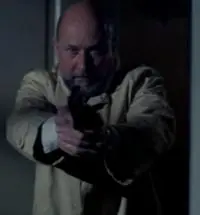 The first thing that should immediately jump out at you is the near redundancy of these two monologues, both in the their word usage and subject matter. In both instances, Loomis is attempting to convince Bracket that he has a serious and deadly problem on his hands, but he more or less provides the same information in both cases: Michael is evil, and I've known it all along. Moreover, that second speech occurs at the behest of Bracket, who has grown tired of Loomis's paranoia and wants to call off the manhunt for Michael. Bracket outright tells Loomis that all he's gotten by way of evidence is a lot of "fancy talk," and he even calls Loomis's second speech "more fancy talk." Loomis doesn't change his tactic at all. He basically repeats himself.
The first thing that should immediately jump out at you is the near redundancy of these two monologues, both in the their word usage and subject matter. In both instances, Loomis is attempting to convince Bracket that he has a serious and deadly problem on his hands, but he more or less provides the same information in both cases: Michael is evil, and I've known it all along. Moreover, that second speech occurs at the behest of Bracket, who has grown tired of Loomis's paranoia and wants to call off the manhunt for Michael. Bracket outright tells Loomis that all he's gotten by way of evidence is a lot of "fancy talk," and he even calls Loomis's second speech "more fancy talk." Loomis doesn't change his tactic at all. He basically repeats himself.
Secondly, how does Loomis know this is what Michael had been planning while he "stared at the wall"? Especially since Michael hasn't spoken a single word since 1963? How, when catatonia is fairly common with institutionalized patients? The only evidence Loomis provides is that he stared into Michael's eyes, and saw the Devil staring back. That's not exactly putting his psychiatric degrees to good use, now is it?
Now of course, we learn at the end of the film that Loomis is right—Michael is indeed pure, unstoppable evil—but there's still no way Loomis could have truly known everything he purports to know. By and large, Loomis kind of appears like a crazed lunatic himself, arriving into town at the same time as Michael, waving his arms and warning the Sheriff of impending evil and doom, even pulling his revolver at the slightest sound. He admits he is terrified, and it is clear he doesn't really have much of a plan other than to watch and wait for Michael. Overall, it does feel as though Loomis is only there to remind the audience, and not any other character in the film, that Michael is EEEEEEVILLLL.
Or is he...?
What Does Work
Let's look at this another way.
Just a heads up: this is about to get a little Room 237, so bear with me...
So here's the thing about Loomis and his relationship with Bracket: he presents virtually no evidence to the Sheriff that Michael will kill again. And yet, despite displaying some obstinance and even suggesting that Loomis might indeed be a lunatic, he goes along with Loomis's "plan," such as it is.
Why does Bracket believe Loomis? Why does he allow this man he's only just met to basically act as the Sheriff without Loomis even being deputized (as far as we know). The doctor calls all the shots, even though he has no authority to do so. He even tells Bracket not to alert local news and radio broadcasters about Michael's presence, because he believes it will generate panic throughout Haddonfield; "they'll see him on every street corner," he says. Wouldn't that be a good thing? If his sole mission in this film is to stop Michael from killing again, wouldn't he want the citizens of this small Midwestern town terrified and closed up in their homes?
Moreover, his decision not to alert the town via television directly correlates with the first onscreen murder we see: Annie, Laurie's friend, was WATCHING TV with little Lindsay Wallace. Perhaps if an emergency broadcast had appeared on the television warning her of an escaped lunatic, she might have locked the house up and told her boyfriend Paul to do the same, instead of ditching Lindsay off on Laurie so she could meet Paul for a little hootchie-cootchie. After all, nookie's no fun if you're dead.
As such, Loomis is as much to blame for the deaths of Annie, Linda, and Bob as Michael is.
Now, Bracket seems like a smart enough man, but he's probably never dealt with something like this before—an escaped lunatic in his nice, quaint little town. Given that this man Loomis does seem to understand his patient, in some ways his acquiescence to the good doctor is understandable. But it's still strange.
Consider this, however: we know already that Michael is no mere escaped lunatic. He is something else entirely, imbued with some supernatural power that makes him indestructible, a true force of evil.
What if Loomis is also imbued with this supernatural power?
Think about it: Michael wishes to spread fear. He targets Laurie because she wasn't afraid to approach his house—the haunted house, the bad place little Tommy Doyle is so scared of, the place he warns Laurie not to approach at the very beginning of the film. She brazenly walks onto the porch and places the key in the mailbox (her father is a realtor, and he is selling the house). Michael's rage thus spurs not from anything remotely sexual, but rather because Laurie is not as terrified of HIS house as Tommy is. So he orchestrates everything that follows—he steals his sister's grave marker, he kills Annie, Linda and Bob, and he creates a second haunted house inside the Wallace place, in which the props are Judith Myers's tombstone, a jack-o-lantern, and the corpses of Laurie's friends. As Sheriff Bracket says to Laurie, "It's Halloween. Everyone's entitled to one good scare." This is Michael's "good scare," created specifically for the brazen, unafraid Laurie. His goal is simple: he wishes to scare the living shit out of her before he takes her life.
But it isn't just Laurie. Michael wants the entire town to fear him again. This is why the film ends with a shot of the Myers house (accompanied by Carpenter's haunting theme music and the sound of the Shape breathing). "Death has come to your little town," Loomis warns Bracket. By the film's conclusion, Michael could be anywhere—and as such, he is EVERYWHERE.
Loomis is complicit in all of this. He helps to spread Michael's legend, because Loomis is the only one who knows what Michael really is—pure evil. He knows that it is Michael's sole purpose to once again stain this idyllic little town. Perhaps Loomis even suspects that this was Michael's only motivation back in 1963, when he murdered his sister and created the Bad Place, which sat empty for fifteen years, the people of Haddonfield refusing to live there because of its horrifying history. And given that Michael escapes and returns home at the same time as his house, his Bad Place, is to be sold off and once again occupied, one wonders if this is a mere plot convenience on the part of Carpenter and Hill, or if this suggests that Michael might possess powers beyond mere immortality. Perhaps the same supernatural force—an entity, even—that imbues Michael with indestructibility also TELLS him the proper moment to strike (as the latter sequels attempted to suggested, albeit poorly). Perhaps it tells him, your house is being sold; people are not afraid anymore; you must go home now...
So if it is true, or at least plausible, that Michael simply knows things he couldn't possibly know (that people are forgetting his Bad Place, his evil), then it stands to reason Loomis could potentially know things he shouldn't either—a man of science, or at least ideally; a man who studies the mind and its intricacies, whose job is to assess and diagnose psychiatric maladies. He is befuddled by Michael, he is terrified of him. And if he ultimately serves as the messenger in this narrative, the figure who arrives in Haddonfield at roughly the same time as Michael—the "White Knight" to Michael's Black—but despite his hero status he only manages to help spread the fear rather than stop it, could it then be argued that perhaps Loomis and Michael are connected to the same psychic channel, that their actions are being controlled by the same supernatural entity, albeit unknowingly in Loomis's case?
Going further, could it be that this entity sent its White and Black Knights to Haddonfield for the same reason? Because really, Michael and Loomis have the same goal—they have to convince people to FEAR Michael.
In this way, despite Loomis's good intentions, is he only aiding the inevitability of fear? Is this why he tells Bracket not to alert the TV and radio stations, despite the glaring benefits behind doing such? Is this why he can't quite put his finger on why Michael is evil? Is this why he's more or less working off a hunch and little else?
If all this is true, then the implications of the film's seasonal setting (and, subsequently, its title), become quite apparent. Remember that modern-day Halloween is a Christianized version of the Gaelic Samhain festival, during which it was appropriate to offer appeasements to the spirits of the dead as well as the aos sí, a "supernatural race" comparable to elves or fairies, who are said to cross into the world of the living during Samhain.
See, there are different types aos sí, one of which is the Sluagh Sidhe. These entities are considered the most violent and vicious. They are also perceived as mischievous tricksters, and possibly even the spirits of the dead. Consider this passage from a website devoted to these spirits (which takes its info from a number of publications, all cited on the page):
The spirits fly about in great clouds, up and down the face of the world like the starlings, and come back to the scenes of their earthly transgressions. No soul of them is without the clouds of earth, dimming the brightness of the works of earth.
Arguably, Michael is or is imbued in some fashion by a Sluagh Sidhe. He is not dead in the technical sense, though his blank stare, muteness, and lack of all emotion make him resemble death. Moreover, the mask he wears is as pale white as dead flesh, which ramps up Michael's connection to the deceased. He too returns to the scene of his transgressions and brings with him a cloud of fear and despair that he spreads over all of Haddonfield by the film's end.
But consider also this passage from the same site:
It is said that the Sluagh 'Commanded men to follow them, and men obeyed, having no alternative. It was these men of earth who slew and maimed at the bidding of their spirit-masters, who in return ill-treated them in a most pitiless manner...'
This easily applies to Michael, if we consider that he is possessed by a Sluagh Sidhe, rather than a Sluagh Sidhe himself. But it can also be said that Loomis is under the same spell. Again, consider that he is an agent of the same goal, to spread fear. He also barrels into Haddonfield, crazed and panicked, toting a gun and speaking emphatically about a force of pure evil that has come home. He seems to know more than he should about Michael, even for a man who observed the boy for fifteen years, and he cannot exactly express why Michael must be stopped. But because Haddonfield is a sleepy, idyllic town, and as such not exactly equipped to deal with this evil (as represented by the good-natured but altogether unprepared Bracket), Loomis is able to assume control over the manhunt and decide not to alert the public at large about the presence of evil in their town, despite the fact it would actually help and better achieve his goal of stopping Michael before he can do anything too horrible.
Is Loomis himself inept? In a way, yes: he is a psychiatrist, not a law enforcement agent. But he is not a stupid man, and his decision to keep the manhunt close to his chest counters his intelligence. Why would he make such a decision, despite every reason not too? It makes sense that Loomis is ALSO possessed by the same Sluagh Sidhe that possesses Michael. He thinks he is there to stop evil, but really, he is only there to aid it. Michael's success in spreading fear is inevitable, and Loomis, though he does not know it, is nothing more than a pawn in this fear-stoking game.
Wrapping it Back Around
So what does all this have to do with Loomis's two speeches? Consider this other point from Robert McKee concerning exposition:
Your characters know their world, their history, each other, and themselves. Let them use what they know as ammunition in their struggle to get what they want.
If the Sluagh Sidhe want to spread fear, what better place to start than with the local law enforcement, Haddonfield's best weapon against stopping Michael from carrying out the final mission? So they make sure Loomis himself shows up to both warn Sheriff Bracket and instill in him fear as well—because what else other than fear convinces Bracket to allow Loomis to call all the shots, despite the fact he thinks Loomis's speeches are "fancy talk"? He is just as afraid as Loomis is, deep down.
In this way, Loomis's speeches are doing far, far more than simply providing the audience with exposition...

About the author
Christopher Shultz writes plays and fiction. His works have appeared at The Inkwell Theatre's Playwrights' Night, and in Pseudopod, Unnerving Magazine, Apex Magazine, freeze frame flash fiction and Grievous Angel, among other places. He has also contributed columns on books and film at LitReactor, The Cinematropolis, and Tor.com. Christopher currently lives in Oklahoma City. More info at christophershultz.com
